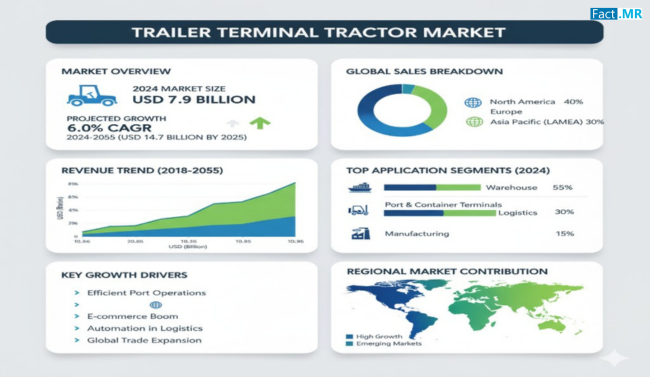The trailer terminal tractor market is witnessing substantial growth as logistics and freight handling operations increasingly rely on efficient, reliable, and specialized vehicles to manage trailer movements within ports, distribution centers, and industrial facilities. Terminal tractors, designed specifically for short-distance hauling, loading, and repositioning of cargo trailers, have become critical to optimizing workflow, reducing turnaround times, and improving safety in high-density logistics environments.
With the rise of e-commerce, global trade expansion, and industrial automation, terminal tractors are playing an essential role in modern supply chain operations. Their adoption reflects the broader industry emphasis on operational efficiency, cost-effectiveness, and sustainability in cargo handling and freight movement.
Market Overview
Trailer terminal tractors, also known as yard trucks, shunt trucks, or yard haulers, are engineered for maneuvering trailers in terminal environments rather than long-haul transportation. Their design prioritizes durability, high maneuverability, quick coupling and uncoupling capabilities, and robust engine performance under continuous short-distance operation.
Modern terminal tractors integrate technological advancements such as telematics, automation, and ergonomic controls to enhance operator efficiency and reduce fuel consumption. Electric and hybrid-powered models are gaining traction, aligning with global initiatives to reduce emissions and promote environmentally friendly logistics solutions.
The market is driven by the increasing need for faster cargo handling in ports, warehouses, and intermodal terminals. Operators are upgrading fleets with advanced terminal tractors to manage growing freight volumes while minimizing operational bottlenecks and downtime.
Additionally, regulatory standards and safety guidelines for material handling are influencing design improvements, including collision avoidance systems, enhanced braking, and operator safety cabins. Terminal tractors are evolving from basic shunting vehicles to intelligent, connected solutions that support the automation of logistics and supply chain operations.
Regional Insights
North America leads the trailer terminal tractor market due to extensive port operations, industrial distribution centers, and a strong logistics infrastructure. Operators in the region are increasingly adopting electric and hybrid models, reflecting environmental initiatives and the need for cost-efficient operations.
Europe follows closely, with growing investments in smart logistics, sustainable freight handling, and modernization of industrial ports and rail terminals. European operators focus on electric-powered terminal tractors, regulatory compliance, and integration with digital fleet management solutions.
Asia-Pacific is emerging as a key growth region, fueled by rapid industrialization, expanding port networks, and increasing e-commerce logistics. Countries such as China, India, and Japan are upgrading cargo handling infrastructure and investing in efficient terminal tractor fleets to support growing trade volumes.
In Latin America and the Middle East & Africa, modernization of logistics hubs, port expansion, and partnerships with international equipment manufacturers are creating new opportunities for terminal tractor adoption. The focus is on improving operational efficiency, reducing cargo dwell time, and supporting regional trade growth.
Key Trends & Forecast
- Electrification and Hybrid Vehicles:
Increasing adoption of electric and hybrid terminal tractors is reducing emissions and aligning with global sustainability initiatives, especially in environmentally regulated ports and industrial facilities. - Fleet Management and Telematics:
Integration of telematics and digital fleet management systems allows operators to monitor performance, optimize routes, track fuel consumption, and reduce maintenance downtime. - Automation and Driver Assistance:
Advanced driver assistance systems, automated steering, and semi-autonomous terminal tractors are enhancing operational efficiency and safety, particularly in high-traffic terminal environments. - Ergonomic and Operator-Focused Design:
Modern terminal tractors are designed with operator comfort in mind, featuring adjustable cabins, intuitive controls, and safety features that reduce fatigue and improve productivity. - Sustainability and Emissions Reduction:
Environmental regulations and sustainability initiatives are driving innovation in low-emission powertrains, regenerative braking systems, and energy-efficient designs. - Integration with Smart Logistics Systems:
Terminal tractors are increasingly integrated with warehouse management systems (WMS) and port operation software to streamline cargo flow, improve scheduling, and optimize yard operations.
These trends underscore the market’s shift toward intelligent, sustainable, and technology-enabled cargo handling solutions.
Applications & End-Use Outlook
Trailer terminal tractors are essential in multiple logistics and industrial applications, including ports, intermodal terminals, warehouse yards, distribution centers, and manufacturing facilities.
In ports and intermodal terminals, terminal tractors handle container movements, trailer repositioning, and ship-to-yard operations. Their efficiency is crucial in reducing ship turnaround times, preventing congestion, and maintaining smooth cargo flow.
Distribution centers and warehouses rely on terminal tractors to shuttle trailers between docking stations, optimize loading and unloading operations, and maintain high throughput. Efficient yard management reduces operational delays and improves supply chain reliability.
In manufacturing and industrial facilities, terminal tractors support in-plant logistics by moving raw materials, semi-finished products, and finished goods across storage and production zones. This enhances workflow coordination, reduces manual handling, and improves safety.
E-commerce and logistics providers are increasingly leveraging terminal tractors for last-mile distribution hubs and high-volume fulfillment centers. Automation, connectivity, and efficient yard handling are becoming essential to meet the growing demand for rapid delivery and order fulfillment.
The market emphasizes operational efficiency, sustainability, and technological integration, making terminal tractors a strategic asset in modern logistics and cargo handling ecosystems.
Conclusion
The trailer terminal tractor market is transforming cargo handling and logistics operations through efficiency, sustainability, and technology-driven solutions. Modern terminal tractors, with advanced powertrains, automation, and digital integration, are helping operators optimize yard operations, reduce emissions, and enhance safety.
As global trade, industrialization, and e-commerce continue to grow, the demand for intelligent and reliable terminal tractors will rise. Manufacturers and logistics providers are investing in innovation, fleet modernization, and eco-friendly solutions to meet evolving operational needs.
Comprehensive market insights can help operators, manufacturers, and logistics companies understand emerging trends, adopt best practices, and implement effective strategies to maximize efficiency and sustainability. Trailer terminal tractors are no longer just vehicles for short-distance hauling — they are critical enablers of modern supply chain productivity and industrial efficiency.
Browse Full Report – https://www.factmr.com/report/5355/trailer-terminal-tractor-market



